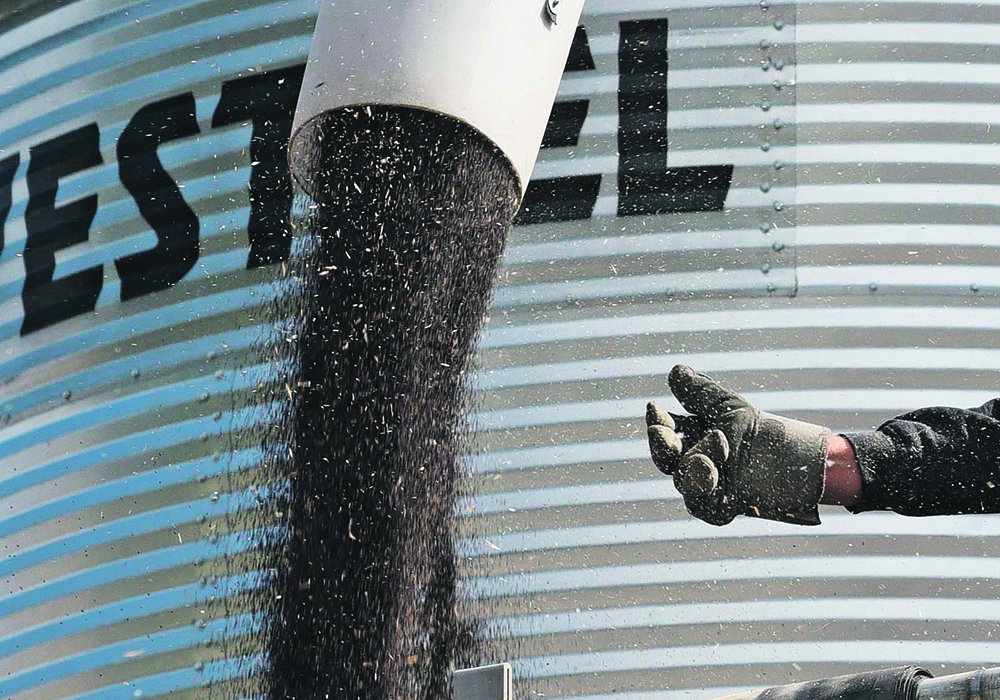Farmers might want to hold off a bit longer on marketing their canola, says an analyst.
MarketsFarm analyst Mike Jubinville is advising growers to wait until prices climb another $1 per bushel before making any more incremental sales.
“I suspect there’s room for an oversold canola market to have some element of bounce to it,” he told growers attending a fall outlook webinar.
Read Also

New fertilizer product aims to reduce tie-up, improve soil health
A new phosphorus fertilizer, launched at Ag in Motion 2025, promises to reduce nutrient tie-up and deliver slow-release feeding throughout the growing season.
Related stories:
MarketsFarm is forecasting 1.4 to 1.5 million tonnes of canola carryout at the end of 2023-24 despite having a bigger production number than Statistics Canada.
“That is still a fairly tight scenario here that we’re proposing,” said Jubinville.
It pegs production at 18 million tonnes. Domestic demand of 10.5 million tonnes will mop up a lot of that supply.
Exports are forecast at 7.5 million tonnes, with four million tonnes headed to China. However, he is a little nervous about that market.
“China so far this year has been oddly sluggish in terms of contracting Canadian canola supply,” he said.
That could be because Russia is suddenly sending 75,000 to 100,000 tonnes of rapeseed oil to China every month.
China is also importing canola seed from Australia and Ukraine.
One thing keeping a lid on the market is cheap European rapeseed prices caused by a tsunami of exports from Ukraine, which harvested 4.5 million tonnes of the crop in addition to big carryover supplies.
Jubinville thinks the new floor for Canadian prices is around $700 per tonne, which is about where prices were at on his Oct. 26 presentation.
Canadian canola is reasonably priced at a $35 to $40 per tonne premium over soybeans. The normal premium is in the $50 to $100 range.
He thinks prices may have bottomed out and should be heading higher over the next couple of months.
Statistics Canada estimates barley production at 7.8 million tonnes. The trade thinks it could be eight to 8.5 million tonnes.
Jubinville is forecasting two million tonnes of exports, much of which is already on the books.
Today’s barley prices, ranging from $6 to $7.20 per bushel depending on location, are not competitive in the export market.
They would need to be $5.35 backed off to mid-Saskatchewan to work in the Chinese market.
“We essentially are very much going to be a domestic market for barley if we’re going to maintain prices at present levels,” he said.
Jubinville is forecasting five million tonnes of domestic demand and 1.2 million tonnes of ending stocks, the highest level in six years.
Western Canada will likely import 2.5 million tonnes of U.S. corn in 2023-24. It is at price parity with barley right now.
He believes U.S. corn will start showing up in mid-November, and barley prices will be tethered to corn from that point on.
Statistics Canada pegged oat production at 2.4 million tonnes. The trade thinks it might be 250,000 tonnes larger than that, but it will still be one of the smallest crops in the past 40 years.
That is because last year’s 5.2 million tonne crop overwhelmed the market and acres fell hard.
Carryout from 2022-23 is estimated at 1.2 million tonnes, so there is still plenty of supply.
“It’s a journey of time,” said Jubinville.
He thinks supplies will tighten up in the second half of the 2023-24 campaign. That should put upward pressure on prices, which need to transition from feed to food prices to attract acres for next year.
Statistics Canada’s pea estimate is 2.3 million tonnes, which he thinks is about 300,000 tonnes too small.
Jubinville is forecasting 2.2 million tonnes of exports, with one million tonnes of that going to China.
Canada will be facing stiff competition from cheap Russian peas in China, although there may be some quality issues with those peas.
The good news is that U.S. soybean meal prices have shot up nearly 20 percent in October due to Argentina running out of soybeans.
That may be creating demand for yellow peas in China’s feed market.
Yellow pea bids are creeping up to $11 per bu. in Saskatchewan and $12 in Alberta.
Another bullish factor is that India’s chickpea crop is in doubt, although a 150,000-tonne pea import quota still exists in that market.
Jubinville said it is hard to figure out where pea prices are going, but he would “meter out” sales into the current appreciating market.
Statistics Canada estimates the lentil crop at 1.5 million tonnes, while the trade believes it is closer to 1.85 million tonnes.
He is forecasting 1.7 million tonnes of exports, down from 2.25 million tonnes last year.
Pigeon pea prices are sky high in India and hold a huge premium over red lentils in that market.
That is going to support Canadian lentil prices, especially green lentils.
The “fly in the ointment” is Australia, which is set to harvest another big crop in December. It is forecast at 1.25 million tonnes, down from last year’s record 1.6 million tonnes but still well above average.
Large green lentil prices are hovering in the 63 to 65 cents per pound range, while reds are in the 35 to 37 cent range.
“This market right now feels kind of grindy,” said Jubinville.
His advice to growers is the same as it is with peas — meter sales into what has been a slowly rising market.
Contact sean.pratt@producer.com
















